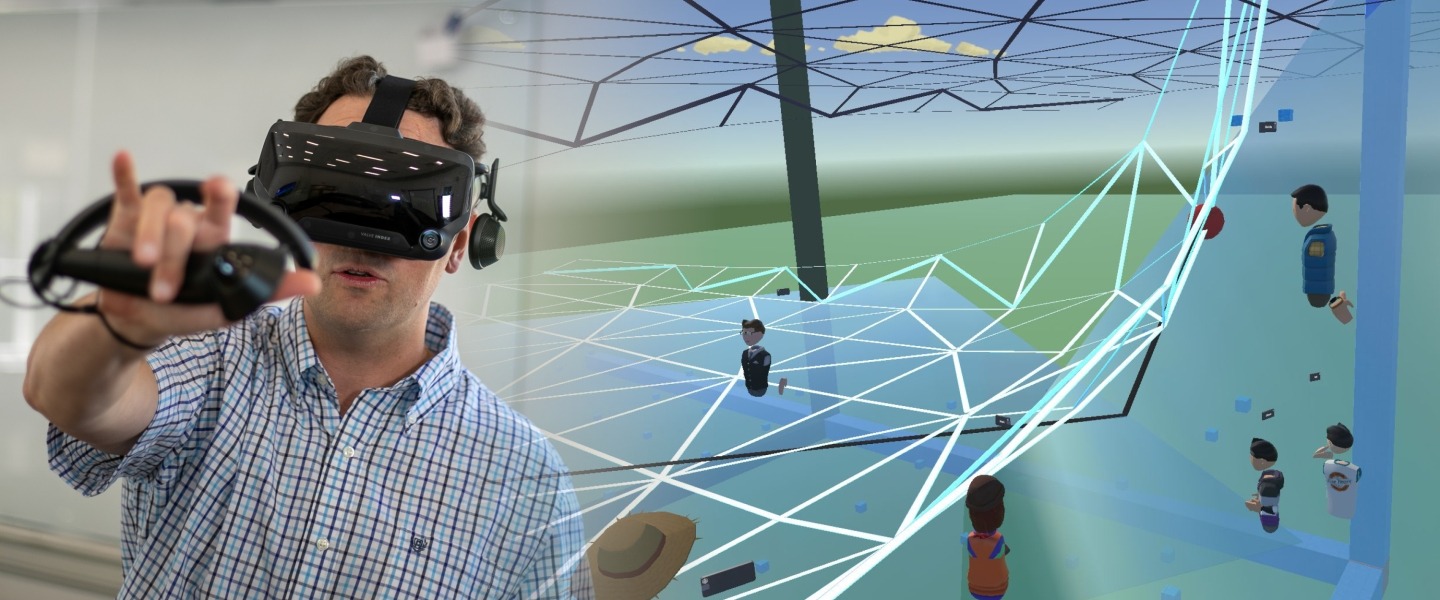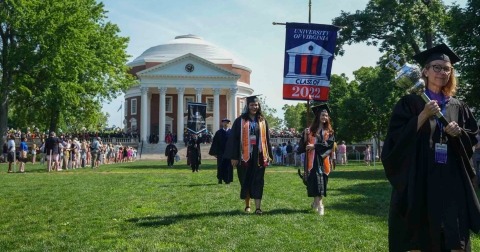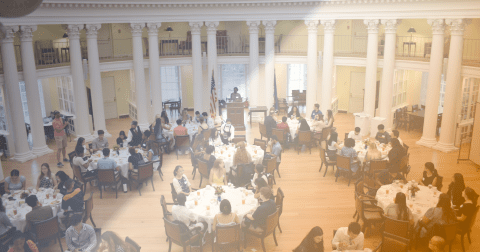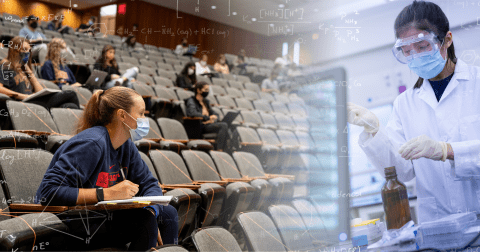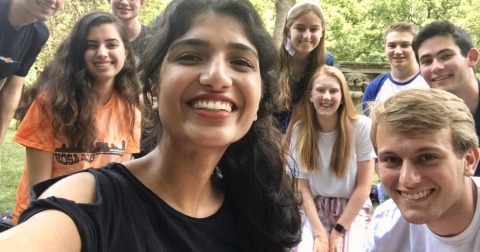Even before the pandemic pushed his classes online for several semesters, assistant economics professor Marc Santugini was trying to devise a better way to help his students at the University of Virginia better visualize the economic principles he was teaching. Traditional and Zoom lectures and discussions didn’t lend themselves to the 3D world he wanted to use to graph economic data and models in a variety of shapes and forms that his students could more fully grasp.
Santugini found an intriguing solution in a world more associated with goggle-wearing, virtual reality gamers: VR headsets. With the support of the Department of Economics, and a Learning Technology Incubator (LTi) grant from the College and Graduate School of Arts & Sciences’ Learning Design & Technology team, Santugini introduced an upper-level economics pilot seminar last year.
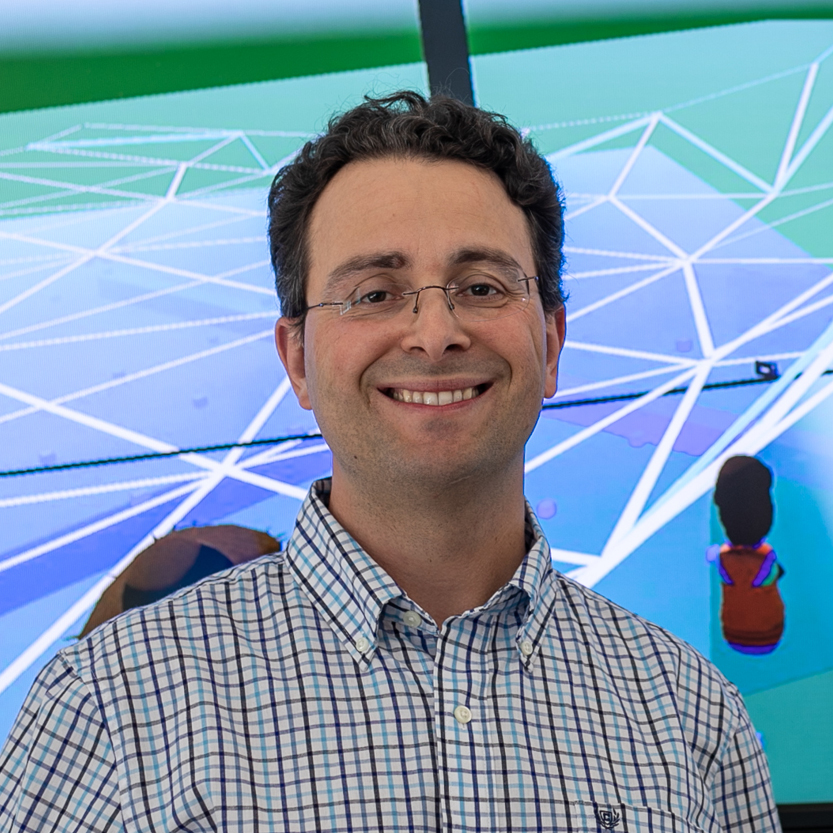 Marc Santugini, Assistant Professor of Economics. Credit: Molly Angevine
Marc Santugini, Assistant Professor of Economics. Credit: Molly Angevine
It is believed to be the first UVA class to be taught entirely in a virtual reality environment, where Santugini’s avatar and those of his four students zoomed up, over and around a variety of towering, 3D graphs of economic data they plotted in a variety of fanciful, digital outdoor settings.
With the assistance of Jason Bennett, a Learning Design & Technology instructional technology project manager who manages a suite of College learning spaces, including the College’s Interactive Media Studio, Santugini has proven to be an early and agile adaptor to the teaching potential in this technology. A growing number of economics majors have been lured by Santugini’s infectious enthusiasm for teaching and VR to don one of the Oculus VR headsets provided by the College via the LTi grant. Over three semesters, the virtual world they inhabit in class has grown with their instructor’s increasing familiarity with the technology, and that of his students.
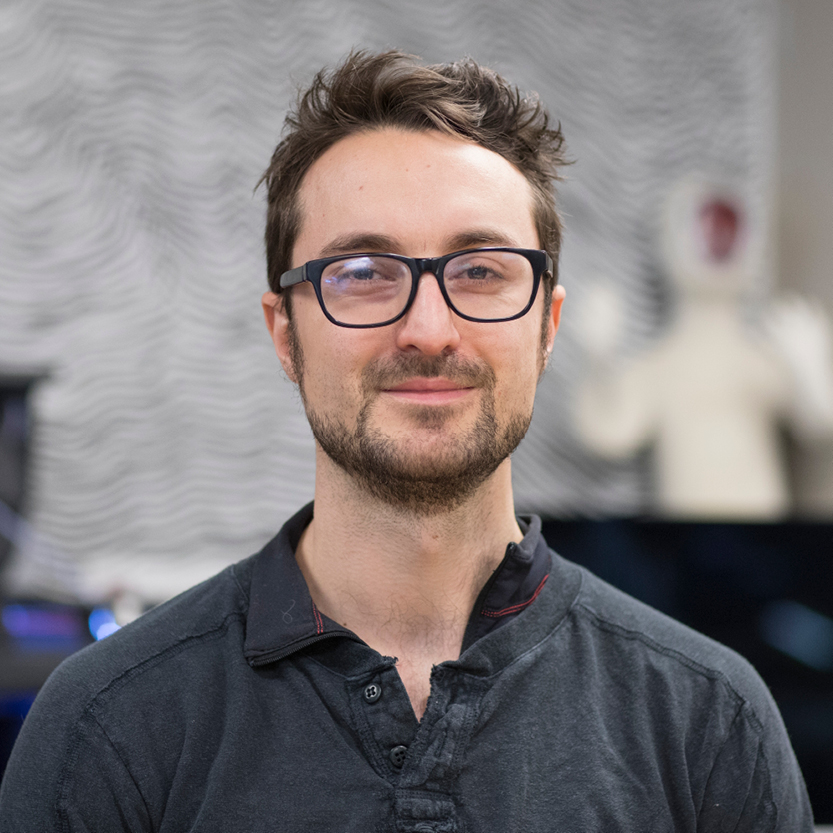 Jason Bennett, A&S Learning Design & Technology instructional technology project manager. Credit: Molly Angevine
Jason Bennett, A&S Learning Design & Technology instructional technology project manager. Credit: Molly Angevine
“We’re not just playing basketball anymore,” Santugini joked, referring to one of the warmup activities he leads new students through as they familiarize themselves with the virtual environment and the hand controls they use to navigate, pick up objects and manipulate them in his “3D Visualization of Economic Models” course.
“Compared to the first semester of the pilot, we are able to do so much more now. Take supply and demand, for example. When we’re in a VR environment, because of the 3D graphing, we can look at allocation problems and how prices are determined in two markets. Suppose you impose a tax in one market. What is the effect on the other market? That's not something I can actually show specifically on a two-dimensional slide, but in VR, I can draw a graph linking the two markets and illustrate these effects more clearly to students.”
First 100% VR Class
There is a learning curve to using the VR headsets. VR rookies wearing a headset for the first time may experience some dizziness or find themselves bumping into the walls of their physical surroundings as the goggles convince them they’re treading oh so carefully atop the peak of Mount Everest. In his office hours, Santugini often lends a headset to an interested student considering taking his VR class to teach the basics of picking up a virtual pen and drawing a graph in the air on the virtual whiteboard that appears in the goggles. Even the basic act of delivering a high five to the avatar of one of his students took some practice at first.
Santugini’s early trial-and-error learning of the technology and ability to teach it quickly to his students was aided greatly by Bennett, who devised virtual tools for Santugini to consult his lecture notes in the virtual world and to more easily write on virtual whiteboards. Bennett also directs several virtual cameras within the VR class to record them and provide different angles of Santugini and his students’ avatars at work.
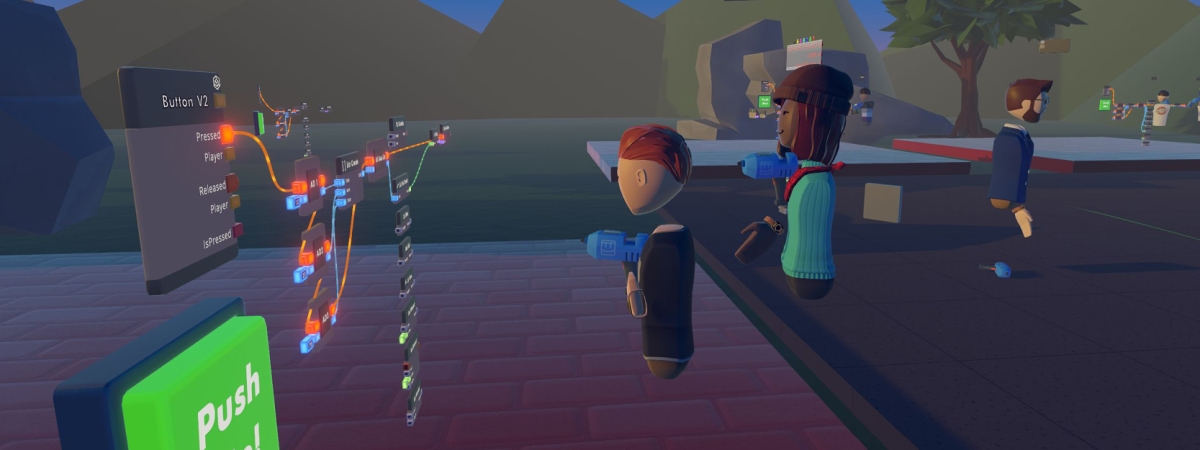 The avatars of two students in Santugini’s “3D Visualization of Economic Models” code together in the seminar’s VR space.
The avatars of two students in Santugini’s “3D Visualization of Economic Models” code together in the seminar’s VR space.
“There are other classes that have used some VR,” Bennett said. “But this one is the first that’s 100 percent in the virtual reality world and using VR as the platform to deliver the class. Our team, Learning Design & Technology, is known for our ability to take faculty proposals to experiment with pedagogies and work with them to co-design teaching and learning that can scale and become sustainable.
“Marc had this sort of passion for the project to overcome that first stage where it feels like you’re just trying to learn to write again in the VR world, like you’re back to holding one of those enormous pencils you start with in grade school. VR is quite powerful, but you need motivation to learn those fundamentals. Once you gain some proficiency, you can not only reach out and draw in the 3D space around you as if it were a 3D whiteboard, you can also examine 3D objects and ideas from all angles as you might a sculpture.”
Students Push Innovation Further
To learn more about how to expand the virtual classroom he envisioned building, Santugini took an online art class utilizing the same Rec Room VR platform that his class uses. Every Monday and Wednesday night, he was working online with artists, gamers and other classmates building virtual haunted houses and other landscapes from scratch. Santugini says his students have been just as valuable in discovering and expanding the VR capabilities of the class.
A highlight reel of Asst. Prof. Santugini's students working on allocation problems and economic models in the seminar's virtual space. (Virtual videography was recorded by Jason Bennett.)
Several students have continued as teaching assistants for the class after completing it. During class sessions, students can press a button on their hand controls and consult with a TA in a “bubble” away from the virtual class to catch up on a specific concept or get help navigating their avatars. Some of the TAs go further and create their own projects within Santugini’s VR world, such as the 3D animation mapping the market price of cryptocurrencies over time created by rising third year Brian Buck this spring.
“One of the things I was really hoping for when I came to college was the chance to work with cutting-edge technology and learning how to apply it in different fields,” said Buck, who was persuaded by a friend to take Santugini’s pilot course last fall before continuing this spring as a TA. “A lot of people are still skeptical about VR, but I look at this as an opportunity to really explore that cutting edge, particularly in economics. Getting a chance to understand VR’s strengths — and its weaknesses — has really been a cool opportunity and is one of the unique things I’ve gotten to do at UVA.”
“One of the things I was really hoping for when I came to college was the chance to work with cutting-edge technology and learning how to apply it in different fields.” - Brian Buck, rising third year
Classmate Chessie LeFrancois, who graduated this spring with a degree in economics and a minor in data science, said that before taking Santugini’s course this spring, her VR experience was limited to putting on a headset briefly at a Microsoft store.
“I didn’t necessarily know the scope of what we were going to do, because in real life, you can’t graph in 3D. When you’re discussing concepts like risk and uncertainty, it’s hard to visualize how all these factors interact when you’re drawing multiple, separate two-dimensional graphs. In 3D, it’s cool to examine these graphs from different angles and where they interact,” said LeFrancois, who will begin working full-time in an analyst position for Bank of America later this summer. “There’s definitely room for growth, and I think it will be really cool to see the technology continue to improve. I hope I can come back in a couple years to see how much it has advanced.”
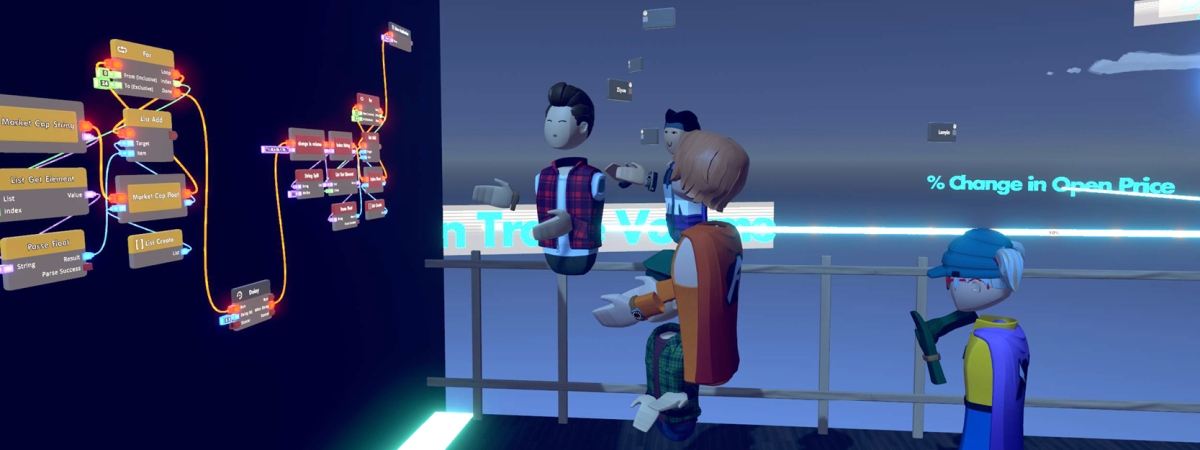 Second-year student Brian Buck, via his VR avatar wearing a red plaid vest, presents a project on cryptocurrency prices to classmates.
Second-year student Brian Buck, via his VR avatar wearing a red plaid vest, presents a project on cryptocurrency prices to classmates.
The College’s Learning Design & Technology team recently renewed Santugini’s LTi grant to continue the VR class next academic year, with the funding going toward the VR headsets, other technological equipment, and paying undergraduate TAs.
Given the cost of the VR headsets and other technological requirements, Santugini’s seminar remains limited to 10 students. (He also will be teaching a fall course titled “Coding for Virtual Reality: Learning in the Metaverse” as part of the College’s new Catalyst program, which offers courses designed to help students flourish in the world of work after graduation.)
Santugini has already introduced VR lessons in a hybrid format to his larger, in-person classes. To share a 3D graph illustrating the concept of profit maximization — the short or long run process by which a firm calculates the input and output levels that will produce the highest profit — Santugini put on his VR headset and wandered the front of the Wilson Hall classroom as the assembled students watched his avatar navigate the graph and its virtual landscape on a large, mounted screen. At the same time, Bennett remotely moved a virtual camera around the VR landscape, providing students in the lecture hall a 3D sense of Santugini’s graph on the screen.
“We’ve learned so much about how to use this technology, and I don’t think we’re done yet,” he said.

